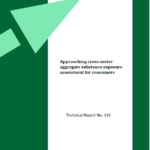Mid-tier approach to aggregated exposure assessment TF
Background
There are increasing public and regulatory concerns regarding potential health risks posed by aggregate exposure, i.e. exposure to (the same) substance from multiple sources via multiple routes. The key questions are whether there is indeed any basis for consideration for aggregate exposure, whether the source-by-source approach can identify or miss significant risks to the environment and human health, and if so, when and by how much. Additional concerns relate to the fact that a substance and its diverse uses can be regulated under different legislations; the question is then how potentially identified risks from aggregate exposure could be best managed when the key exposure sources fall under different regulatory regimes.
Currently, these questions are addressed by following a tiered approach to aggregate exposure assessment (AEA). However, work undertaken in 2016 by the ECETOC TF on Effective Use of Human Exposure Data revealed that meaningful aggregate (consumer) exposure assessment is only possible with high tier approaches that rely on detailed (distributional) exposure factors data.
To further tackle this topic, a Task Force on ‘Mid-tier approach to aggregated exposure assessment’ was formed in 2020; the Task Force intends to build on previous ECETOC work and explore suitable methodologies/tools for a mid-tier aggregate exposure assessment (AEA) that would determine the key exposure sources for a given substance, or whether a more detailed aggregate assessment would be useful.
Objectives
The Task Force identified the following objectives:
- Explore suitable methodologies/tools for a mid-tier AEA
- Estimate reasonable worst-case or realistic AE
- Criteria for the need and scope of a more detailed assessment
- Address the complexities/uncertainties stemming from combination of different exposure assessment methods/tools, multiple lines of evidence and independent sources of information
- Widen scope to products beyond cosmetics and food (e.g. household and DIY products, articles), investigate methodologies applicable to both consumers and workers
Timeline
The Task Force started work mid-2020, and had completed the majority of its work by early 2023.
Deliverables
The Task Force published an ECETOC Technical Report (TR No. 142) in December 2023.
ECETOC will use the findings and recommendations from this work to consider next steps to advance the science of aggregate exposure assessment.
Recent updates and publications
TR 142 - Approaching cross-sector aggregate substance exposure assessment for consumers

